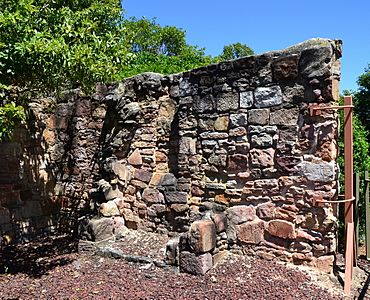Blaxland, New South Wales facts for kids
Quick facts for kids BlaxlandNew South Wales |
|||||||||||||||
|---|---|---|---|---|---|---|---|---|---|---|---|---|---|---|---|

Remains of Pilgrim Inn, c. 1825
|
|||||||||||||||
| Population | 7,451 (2016 census) | ||||||||||||||
| Established | 1830 | ||||||||||||||
| Postcode(s) | 2774 | ||||||||||||||
| Elevation | 234 m (768 ft) | ||||||||||||||
| Location |
|
||||||||||||||
| LGA(s) | City of Blue Mountains | ||||||||||||||
| State electorate(s) |
|
||||||||||||||
| Federal Division(s) | Macquarie | ||||||||||||||
|
|||||||||||||||
Blaxland is a town located in the amazing Blue Mountains region of New South Wales, Australia. It's about 65 kilometres west of Sydney. Blaxland sits at 234 metres above sea level. It shares its borders with the towns of Glenbrook, Mount Riverview, and Warrimoo.
Contents
History of Blaxland
Blaxland got its name from Gregory Blaxland. In 1813, he was one of the explorers who found a way to cross the Blue Mountains. Before 1879, this area was known as Wascoe.
The Pilgrim Inn was built around 1825. It was a very important building in the early days. Today, only its remains are left, next to a McDonald's restaurant. These old remains are considered important history and are protected.
In the early 1900s, a person named Rev. Joshua Hargrave helped Blaxland grow a lot. He built the first church in the area. His family and the Calver family are connected to four old homes that are still standing today. These homes are Tanfield and Menahne on Hope Street, and Rosedale and Nardi on View Street. All these homes are also protected because of their history.
Special Places in Blaxland
Blaxland has several places that are protected for their historical or natural importance. These are called heritage-listed sites.
- Blue Mountains National Park: This includes many walking tracks for you to explore.
Who Lives in Blaxland?
According to the 2016 census, there were 7,451 people living in Blaxland.
- About 2.0% of the people were Aboriginal and Torres Strait Islander.
- Most people, 82.2%, were born in Australia. The next biggest group, 5.0%, came from England.
- Almost everyone, 92.1%, spoke only English at home.
The 2021 Census looked at people's religious beliefs:
- Most people, 94.7%, followed Christianity.
- The biggest Christian groups were Anglicanism (42.3%), Catholicism (24.7%), and Presbyterianism (22.9%).
- About 3.7% of people didn't say their religion, and 1.6% said they had no religion.
Getting Around Blaxland
Blaxland railway station is part of the NSW TrainLink train network. You can catch trains from here to other towns in the Blue Mountains. The station is also designed to be easy for people with disabilities to use.
Shops and Businesses
Blaxland's main shopping area got a big makeover in 2001. The Great Western Highway was made wider, which created more space for shops. Many businesses were updated and improved. These changes, along with the upgraded train station, have helped businesses in Blaxland do well.
Blaxland also has a small area for factories and businesses. It is home to the only remaining place in the Blue Mountains where waste is buried in the ground.
Community Services
Blaxland offers several important services for its residents:
- Blue Mountains Library branch: You can find this library on Hope Street.
- Blaxland Rural Fire Brigade: This local fire station is part of the statewide Rural Fire Service. They help keep the community safe from fires.
Schools in Blaxland
Blaxland has several schools for students:
- Blaxland High School
- Blaxland East Public School
- Blaxland Public School
Fun and Sports
Bushwalking Adventures
Blaxland is a great place for walking in nature. You can explore the Florabella Pass track, which goes all the way to Glenbrook. There's also the Pippas Pass track, which leads to a cool swimming spot on Glenbrook Creek. Nearby, you can visit the historic Lennox Bridge and Knapsack Viaduct by following Mitchell's Pass.
Blaxland Redbacks Sports Teams
Blaxland is home to the Blaxland Redbacks soccer and netball teams.
The soccer team started in 1965. Their home ground is St. Johns Oval in Blaxland. The land for the soccer fields was originally given to the club by the local St. Johns Ambulance Brigade.
Wascoe Siding Miniature Railway
The Wascoe Siding is a Miniature Railway that was started in 1964 by John Green. It was built in an old railway cutting that was no longer used for the main train line. Today, it's a fun place for people who love miniature trains and for those interested in history.
Scouts Club
Blaxland also has its own Scout group, the 1st Blaxland Scout group. They offer exciting activities and learning experiences for young people.
Gallery







